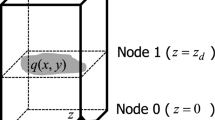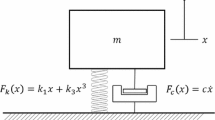Abstract
The method of fundamental solutions, one of the promising boundary-type meshless methods, is proposed as a direct procedure to formulate and analyze the vibroacoustic problem. The coupled system discussed in this study is composed of an acoustic-cavity and excited by an external force or an internal sound source harmonically. The wall of cavity consists of the beam or the plate components, respectively, in two- and three-dimensional problems. The two independent sub-systems interact at the interface simultaneously by satisfying the necessary equilibrium and compatibility conditions. The mathematical formulations described by the presented meshless method demonstrate straightforwardly the frequency responses of the vibroacoustic problems with no boundary integrals. General characteristics of the dynamic coupling effect are displayed, based on the systematic natural frequencies and mode shapes. Feasible results simulated by the presented numerical scheme are validated through meshless numerical experiments including the acoustic-wave propagation problems and the vibroacoustic problems.
Similar content being viewed by others
References
Chen JT, Hong HK (1993) On the dual integration representation of boundary value problem in Laplace equation. Eng Anal Bound Elem 4: 114–116
Chen JT, Wu CS, Chen KH (2005) A study of free terms for plate problems in the dual boundary integral equations. Eng Anal Bound Elem 29: 435–446
Chen JT, Wu CS, Lee YT, Chen KH (2007) On the equivalence of the Trefftz method and method of fundamental solutions for Laplace and biharmonic equation. Comput Math Appl 53: 851–879
Jin WG, Cheung YK, Zienkiewicz OC (1993) Trefftz method for Kirchhoff plate bending problem. Int J Numer Meth Eng 36: 765–781
Monaghan JJ (1994) Simulating free surface flows with SPH. J Comput Phys 110: 399–406
Amaziane B, Naji A, Ouazar D (2004) Radial basis function and genetic algorithms for parameter identification to some groundwater flow problems. Comput Mater Contin 1: 117–128
Kupradze VD (1964) A method for the approximate solution of limiting problems in mathematical physics. Comput Math Math Phys 4: 199–205
Fairweather G, Karageorghis A (1998) The method of fundamental solutions for elliptic boundary value problems. Adv Comput Math 9: 69–95
Karageorghis A, Fairweather G (1987) The method of fundamental solutions for the numerical solution of the biharmonic equation. J Comput Phys 69: 9–26
Young DL, Tsai CC, Lin YC, Chen CS (2006) The Method of Fundamental Solutions for Eigenfrequencies of Plate Vibrations. Comput Mater Contin 4: 1–10
Young DL, Tsai CC, Fan CM (2004) Direct approach to solve non-homogeneous diffusion problems using fundamental solutions and dual reciprocity methods. J Chin Inst Eng 27: 569–597
Fairweather G, Karageorghis A, Martin PA (2003) The method of fundamental solutions for scattering and radiation problems. Eng Anal Bound Elem 27: 759–769
Alves CJS, Valtchev SS (2005) Numerical comparison of two meshfree methods for acoustic wave scattering. Eng Anal Bound Elem 29: 371–382
Ochmann M (2004) The complex equivalent source method for sound propagation over an impedance plane. J Acoust Soc Am 116: 3304–3311
Cisilino AP, Sensale B (2002) Application of a simulated annealing algorithm in the optimal placement of the source points in the method of the fundamental solutions. Comput Mech 28: 129–136
Hong KL, Kim J (1995) Analysis of free vibration of structure-acoustic coupled system. Part I: development and verification of the procedure. J Sound Vib 188: 561–575
Hong KL, Kim J (1995) Analysis of free vibration of structure-acoustic coupled system. Part II: two- and three-dimensional examples. J Sound Vib 188: 577–600
Guy RW, Bhattacharya MC (1973) The transmission of sound through a cavity-backed finite plate. J Sound Vib 27: 207–223
Lee YY (2002) Structure-acoustic coupling effect on the nonlinear natural frequency of a rectangular box with one flexible plate. Appl Acoust 63: 1157–1175
Lee CM, Larry HR, Robert DC (1995) Formulation for an FE and BE coupled problem and its application to earmuff-earcanal system. Eng Anal Bound Elem 15: 305–315
Pretlove AJ (1966) Forced vibrations of a rectangular panel backed by a closed rectangular cavity. J Sound Vib 3: 39–47
Tanaka M, Masuda Y (1987) Boundary element analysis of some structure-acoustic coupling problems. In: Theory and application of BEM, pp 407–419
Everstine GC, Henderson FM (1990) Coupled finite element/boundary element approach for fluid structure interaction. J Acoust Soc Am 87: 1938–1947
Sladek V, Sladek J, Tanaka M (1994) Boundary-element solution of some structural-acoustic coupling problems using the multiple reciprocity method. Commun Numer Methods Eng 10: 237–248
Chien CC, Rajiyah H, Atluri SN (1990) An effective method for solving the hypersingular integral equation in 3D acoustics. J Acoust Soc Am 88: 918–937
Tang HB, Wu CJ, Huang XQ (2007) Vibroacoustic analysis for a uniform beam using composite Green function method. Appl Acoust 168: 1386–1399
Grilli S, Pedersen T, Stepanishen P (1998) A hybrid boundary element for shallow water acoustic propagation over an irregular bottom. Eng Anal Bound Elem 21: 131–145
Author information
Authors and Affiliations
Corresponding author
Rights and permissions
About this article
Cite this article
Wu, C.S., Young, D.L. & Fan, C.M. Frequency response analyses in vibroacoustics using the method of fundamental solutions. Comput Mech 47, 519–533 (2011). https://doi.org/10.1007/s00466-010-0558-1
Received:
Accepted:
Published:
Issue Date:
DOI: https://doi.org/10.1007/s00466-010-0558-1




